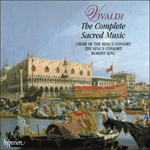In the late 1720s Vivaldi’s connections with the court at Dresden became strengthened. His loyal advocate and former pupil Johann Georg Pisendel took over the direction of the court orchestra in 1728, and a group of seven singers who had been trained in Venice for six years at the court’s expense (two of them as fee-paying boarders at the Pietà) arrived in 1730. The two motets collected by Zelenka (see above) very possibly reached him soon afterwards via one of these singers. The text of this motet for soprano employs the standard operatic metaphor of a ship buffeted by heavy seas that the helmsman is able to steer safely into port—in this case with the aid of the stella maris, the Virgin Mary. One progressive feature of the first aria is the use of a different metre and slower tempo for the central (‘B’) section. This strong musical contrast parallels the difference in mood between the ‘A’ and ‘B’ sections of the text. The final ‘Alleluia’ demonstrates Vivaldi’s rhythmic and harmonic inventiveness even when the texture becomes reduced to only two ‘real’ parts.
from notes by Michael Talbot © 1999
La fin des années 1720 vit le renforcement des liens entre Vivaldi et la cour de Dresde. En 1728, Johann Georg Pisendel—fidèle défenseur et ancien élève du compositeur—prit la direction de l’orchestre de la cour, où arrivèrent, en 1730, sept chanteurs formés durant six ans à Venise, aux frais de la cour (deux d’entre eux avaient été pensionnaires privés à la Pietà). Le texte de ce motet pour soprano use de la métaphore classique d’opéra, mettant en scène un bateau ballotté par une mer déchaînée, que son timonier parvient à amener au port sans dommage—en l’occurrence, avec l’aide de la stella maris, la Vierge Marie. L’une des caractéristiques nouvelles de la première aria tient à l’utilisation d’un mètre différent et d’un tempo ralenti pour la section centrale («B»). Ce contraste musical marqué renvoie à la différence d’atmosphère entre les sections «A» et «B» du texte. L’«Alléluia» final démontre, quant à lui, l’inventivité rythmique et harmonique de Vivaldi, même lorsque la texture se réduit à seulement deux parties «réelles».
extrait des notes rédigées par Michael Talbot © 1999
Français: Hyperion Records Ltd
Gegen Ende der 1720er Jahre knüpfte Vivaldi engere Verbindungen zum Dresdener Hof. Sein treuer Fürsprecher und ehemaliger Schüler Johann Georg Pisendel übernahm 1728 die Leitung des Hoforchesters, und 1730 traf dort eine Gruppe von sieben Sängern ein, die sechs Jahre lang auf Kosten des Hofs in Venedig ausgebildet worden waren (zwei davon als Kostgänger in der Pietà). Der Text dieser Motette für Sopran verwendet die gängige Opernmetapher vom Schiff, das von hohen Wellen hin und her geworfen, aber schließlich vom Steuermann sicher in den Hafen gebracht wird—in diesem Fall mit Hilfe der stella maris, der Jungfrau Maria. Ein progressives Merkmal der ersten Arie ist der Einsatz eines anderen Metrums und langsameren Tempos für den Mittelteil („B“). Dieser starke musikalische Kontrast geht einher mit der unterschiedlichen Stimmung im „A“- und „B“-Teil des Texts. Das abschließende ‘Alleluja’ zeugt von Vivaldis rhythmischem und harmonischem Einfallsreichtum, selbst dort, wo sich die Struktur auf nur zwei ‘echte’ Stimmen reduziert.
aus dem Begleittext von Michael Talbot © 1999
Deutsch: Anne Steeb/Bernd Müller


 Vivaldi: The Complete Sacred Music
Vivaldi: The Complete Sacred Music
